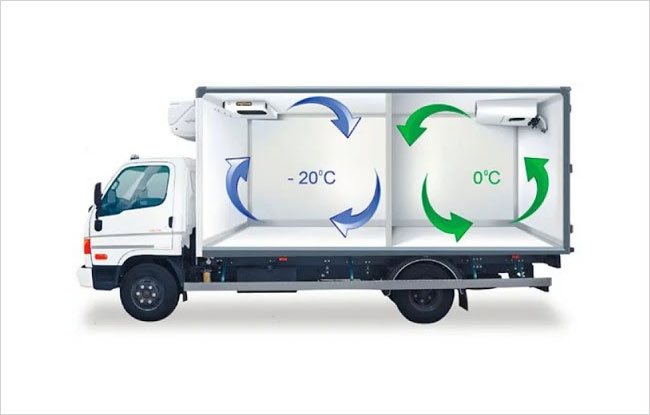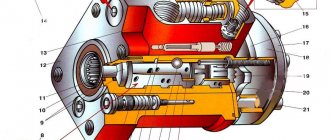A refrigerator truck is an isothermal van equipped with a refrigeration unit. It is designed for the safe transportation of goods that require compliance with a certain temperature and humidity regime. These are mainly food products, medicines, fresh flowers and other perishable goods. The base for a refrigerator can be a van of a minibus, a truck, as well as a trailer or semi-trailer, for transportation of which a tractor is used.
Order a free consultation on choosing a referral
Each refrigeration unit corresponds to a specific class. Therefore, when you choose which refrigerator is best to buy for work, first of all focus on the temperature regime required for the group of goods being transported. You also need to take into account the vehicle’s carrying capacity and the distance over which transportation is planned. To find out more about which refrigerator is best to buy for your business, order a free consultation directly on our website.
The autonomous ref has the lowest fuel consumption - it is installed only on vans with a volume of 30 m³ or more
What types of refrigerators are there?
On the territory of the Russian Federation, the European classification of refrigerators is used. According to it, each refrigeration unit must meet the requirements of one of six classes:
- A – from +12°C to 0°C
, used for transporting dairy products, fruits, vegetables, herbs, fresh flowers and medicines; - B – from +12°C to -10°C
, used for transporting meat and dairy products, as well as fresh fish; - C – from +12°C to -20°C
, used for delivery of chilled and deep-frozen products; - D – no more than +2 °C
, used for transporting dairy products, medicines and flowers; - E – maximum temperature -10 °C
, used for transporting deep-frozen fish and meat; - F – maximum temperature -20 °C
, used for delivery of deep-frozen products.
The classification of a refrigerator depends on its ability to maintain a certain temperature in the van for 12 hours or more, regardless of the air temperature outside the truck. The volume of the van and the carrying capacity of the vehicle have a direct impact on the length of the route:
- “Gazelles” and other small-tonnage vehicles with a van volume of up to 12 m³ and a load capacity of up to 1.5 tons are most often used for transporting goods within populated areas;
- Vehicles with a van volume of 15-20 m³ and a carrying capacity of up to 5 tons are suitable for delivering perishable goods both within the territory of one city and between nearby settlements;
- Large commercial vehicles, with a van volume of up to 60 m³ and a carrying capacity of up to 15 tons, are used for transporting large quantities of goods along intercity routes;
- Refrigerators on trailers and semi-trailers with a van volume of up to 80 m³ and a carrying capacity of over 15 tons are used for transporting large volumes of frozen products on interregional routes.

Ref class is determined by its ability to maintain a certain temperature for 12 hours or longer
What to consider before choosing a refrigerator
When choosing a refrigerator, you should take into account not only its class, the vehicle's carrying capacity and the volume of the van. It is also necessary to pay attention to other nuances that can have a direct impact on transport costs. First of all, you need to decide on the drive of the refrigeration unit: it can be either autonomous or from the engine or generator of the car. Lowest fuel consumption
an autonomous refrigerator, but it can only be installed on vans with a volume of 30 m³ or more.
The type of freon
can be found out by the marking on the thermal expansion valve of the refrigeration unit, and the type of oil can be found in the instruction manual. This information determines how much maintenance of the refrigerator will cost.
Important!
The refrigerator you choose must be certified, and its installation must be carried out by a company with a license to install such equipment. These are mandatory conditions for registering a truck with a refrigeration unit with the traffic police.
Principle of operation
Let's consider the cooling technology inside "heat-cold" type refrigerators. This process is performed in several sequential steps:
- The refrigerant, which is in a gaseous state, is supplied by the system to the compressor. Using special technology inside this part of the structure, gas is converted into liquid.
- Capacitors are used to lower the temperature. In this case, a lot of heat is released, which is removed to the external environment.
- At this stage, the liquid is supplied to the receiver, which cleans it of impurities and excess moisture. This part of the system is also used as a storage device.
- After this, the liquid is supplied to the thermostatic valve, where it turns into gas. This process requires a large amount of heat, which is taken from the refrigerator chamber. The gas then enters the condenser.
The operating principle of a refrigerator is very similar to the functioning of a large refrigerator. As for devices with cooling plates, the temperature in them is reduced due to special mechanisms. After this, they gradually warm up. This approach is used for vehicles transporting ice cream.
5 giants of the auto world: the largest cars
How to protect the gas filler flap?
Official taxis of Domodedovo Airport switched to fixed prices
Characteristics of gasoline AI 80
What are car components and types of repairs?
Tweet
21.06.2017
0 Comments
What brands of refrigerators are there?
There are about a dozen companies represented on the Russian refrigeration equipment market, and the products of each brand have their own characteristics. Here at , you can buy refrigerators from the following manufacturers:
- "Thermo King" - high quality compact refrigeration units made in the USA. They are easy to install, provide a high degree of cooling capacity, and have service support in Russia.
- “Elinzh” are domestically produced refrigerators with a high level of cold. They are distinguished by compact dimensions and increased reliability of connecting pipes and fittings.
- "H-Thermo" - relatively inexpensive South Korean refrigeration units. They can boast of a decent level of quality and low prices for spare parts.
- "Carrier" - high-quality refrigerators from the famous French brand. Refrigeration units are presented in a wide range, distinguished by ergonomics, environmental friendliness and low noise levels. They have increased requirements for the bodies of isothermal vans.

The XOU drive can be either autonomous or from a vehicle engine or generator
The principle of operation of automobile refrigerators
The installation functions similarly to a household refrigerator. Freon (a gas that boils at low sub-zero temperatures) circulates in a closed circuit, going through several stages in turn:
- Using a compressor under pressure, freon is compressed to 18 atmospheres. The process occurs with increasing temperature (up to +130).
- In the condenser, the refrigerant turns into a liquid state and releases heat to the outside.
- Through a drying filter (receiver-dryer), which traps water particles, the liquid enters the expansion valve (thermostatic expansion valve). This part of the circuit is responsible for changing the temperature regime: the expansion valve regulates the amount of freon entering the evaporator.
- The volumetric evaporator tank is equipped with fans to pump air through the chamber. Here the pressure decreases, the freon boils. In this case, heat is absorbed from the outside air. The water condenses and drains out through the drainage system.
- The freon returns to the compressor and the cycle repeats.
The required temperature is set by the settings and then automatically adjusted by the thermostat. The range is from minus to plus 25.
That's why you need to choose a refrigerator wisely
17 tips from an expert
note
For the simultaneous transportation of two or more types of goods with different temperature requirements, there are multi-temperature models: separate sections are provided for products, each with its own temperature.
Refrigeration equipment has manual and automatic defrosting functions. Control - either electromechanical or using a built-in microprocessor controller. The control panel is located in the driver's cab.
The operating conditions of “auto-refrigerators” are different from household ones: vibration places increased demands on the design of working parts and manufacturing materials.
The main reasons to buy a refrigerator from Business Auto
Our group is the official dealer of the largest manufacturers of refrigeration units. From us you can buy refrigerators, as well as original spare parts for them at a competitive price.
In the service centers of our company (Moscow, St. Petersburg, Krasnodar, Yekaterinburg, Krasnodar, Tyumen), experienced craftsmen perform a full range of work on installation, repair and maintenance of equipment of domestic and foreign production. We have all the necessary certificates to provide this type of service and provide an official guarantee for up to 2 years. To get detailed information, order a call back on the website or contact us in another convenient way. Our manager will answer all your questions and help you choose the best refrigerator for the job.
Order a consultation on choosing a refrigerator
Refrigerator
Refrigerator
(from Latin refrigeratus - chilled, refrigero - I cool)
a vehicle with a refrigeration unit (See Refrigeration Unit) for the transport of food products under artificial refrigeration. In road transport, refrigerated vehicles—cars, trailers, and semitrailers with heat-insulated bodies—are used as refrigeration vehicles. Their outer and inner cladding is made of duralumin sheets or galvanized iron. Polystyrene foam and aluminum foil with air gaps are usually used as insulation. Compression refrigeration machines (See Refrigeration machine) of these types are driven by independent carburetor internal combustion engines. Temperature control range from 9 to -18 °C. Load capacity of vehicles - R. reaches 2.5 tons, and semi-trailers - R. - up to 5 tons. In railway transport, refrigerated trains are used as refrigeration (see Refrigerated train), and in water transport - refrigerated ships (See Refrigerated ship).
Source: Great Soviet Encyclopedia on Gufo.me
Meanings in other dictionaries
- refrigerator - refrigerator m. 1. Part of the refrigeration unit where liquid evaporates and a low temperature is formed. 2. A wagon, ship, car, etc., equipped with refrigeration machines for the transportation of perishable goods. Explanatory Dictionary by Efremova
- Refrigerator - (from Latin refrigero - I cool) - a vehicle with a refrigeration unit (car, train, ship) for transporting products at low temperatures achieved by artificial refrigeration. Automobile dictionary
- refrigerator - orf. refrigerator, -a Lopatin's Spelling Dictionary
- refrigerator - REFRIZER'ATOR, refrigerator, male. (French refrigerateur from Latin frigeo - I cool) (tech.). 1. The part of the refrigeration machine in which the liquid evaporates and a low temperature is obtained. 2. A ship or wagon equipped with a refrigerator for transporting perishable products. Ushakov's Explanatory Dictionary
- REFRIGERATOR - A vehicle with a refrigeration unit (car, train, ship) for transporting products at low temperatures achieved by artificial refrigeration. Economic dictionary of terms
- refrigerator - REFRIGERATOR, -a, m. Fat, corpulent person. Explanatory dictionary of Russian argot
- refrigerator - REFRIGERATOR -a; m. [from lat. refrigero - refrigerate] A cargo vehicle equipped with a refrigeration unit for transporting perishable goods. Refrigerated train. Refrigerated vehicle. ◁ Refrigerated, -aya, -oh. R-th ship. R-th installation. Kuznetsov's Explanatory Dictionary
- refrigerator - REFRIGERATOR, a, m. (special). 1. Part of a refrigeration machine, in which a low temperature is formed due to the evaporation of liquid, a cooler. 2. A ship, carriage or car equipped with refrigeration units. | adj. refrigerated, oh, oh. Ozhegov's Explanatory Dictionary
- refrigerator - REFRIGERATOR a, m. refrigerateur <lat. refrigerare cool <lat. frigus cold. 1. Part of the refrigeration unit where liquid evaporates and low temperatures form. BAS-1. Dictionary of Gallicisms of the Russian language
- refrigerator - a, m. A ship, wagon, car, etc., equipped with a refrigeration unit for transporting perishable products. Refrigerated train. Small academic dictionary
- refrigerator - Refrigerator/. Morphemic-spelling dictionary
- refrigerator - Refrigerator, m. [fr. refrigerateur from Latin. frigeo – cool] (tech.). 1. Part of a refrigeration machine in which the liquid evaporates and a low temperature is obtained. 2. A ship or wagon equipped with a refrigerator for transporting perishable products. Large dictionary of foreign words
- refrigerator - Refrigerator, refrigerators, refrigerator, refrigerators, refrigerator, refrigerators, refrigerator, refrigerators, refrigerator, refrigerators, refrigerator, refrigerators Zaliznyak's Grammar Dictionary
- REFRIGERATOR - REFRIGERATOR (from Latin refrigero - I cool) - a vehicle with a refrigeration unit (car, train, ship) for transporting products at low temperatures achieved by artificial refrigeration. Large encyclopedic dictionary
- refrigerator - noun, number of synonyms: 8 car 369 refrigerated truck 4 refrigerated container 2 cryorefrigerator 2 semi-trailer 34 refrigerated trailer 2 fruit carrier 2 refrigerator on wheels 1 Russian synonym dictionary
- Blog
- Jerzy Lec
- Contacts
- Terms of use
© 2005—2020 Gufo.me









